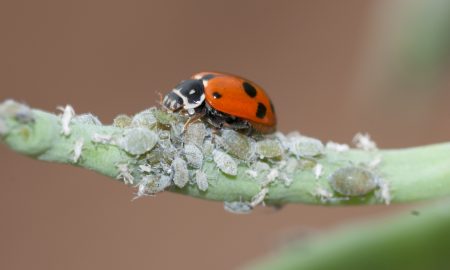As a species with an annual life-cycle and only one generation per year, the brown pasture looper (Ciampa arietaria)is pretty predictable.
Step 1 – Adult moths emerge from pupal cases and lay their eggs during autumn.
Step 2 – Larvae hatch from the eggs, feed on broadleaf plants, such as canola, lucerne and capeweed, and grow to full size in about two months.
Step 3 – Larvae reach full size in spring, pupate and remain dormant over summer.
Repeat.
So, it is not surprising that the brown pasture looper has been reported in several crops and pastures around south-eastern Australia over the past two weeks.
But what is surprising is that this typically broadleaf-plant-feeder, has been nibbling cereals!
Near Elmore in the Victorian Northern Country, they have been spotted on two barley crops. There were around 1 – 5 larvae/m² and the damage is not extensive.
In wheat crops in the Temora region of the NSW Riverina, 3 – 4 small brown pasture loopers per plant have been observed and may require control if the feeding become more voracious as the loopers grow.
How to spot a brown pasture looper
Brown pasture looper larvae are relatively easy to identify once you know what to look for.
The distinctive feature is two bright yellow, wavy lines running down along the back.
Another key to identification are the ‘prolegs’. These are the fleshy, leg-like appendages that caterpillars use to move (the ‘prolegs’ are not to be confused with the three sets of thoracic ‘true legs’ that the brown pasture looper also sports near the head).
While most caterpillars have four sets of abdominal prolegs, the brown pasture looper only has one set. They use their single pair of abdominal prolegs and one pair of anal prolegs to move using a series of back arches, which results in a characteristic looping motion.
To further confirm the identification of a suspected brown pasture looper, flip the larva onto its back or side and observe how many sets of abdominal prolegs it has.

Management
While brown pasture looper is mostly a minor and sporadic species, chemical control is sometimes necessary when populations are high. Unfortunately, there are no economic thresholds to help guide spray decisions with the brown pasture looper, but here is some information that may assist if you:
- Broadleaf plants are their preferred host, and therefore damage is likely to be greater in these crops than cereals.
- The brown pasture looper is often found on broadleaf weeds, especially capeweed. If they are concentrated on weeds in paddocks, they may move onto the crop once weeds are defoliated or if they are sprayed out.
- As caterpillars grow in size, their appetite increases and most damage is done during their final life stages. The brown pasture looper larva grows to around 35 mm.
- Control of brown pasture looper can be assisted by natural enemies including parasitic wasps. They are also prey to spined predatory shield bugs and glossy shield bugs as young larvae.
- If brown pasture loopers are concentrated in weedy areas or in patches, spot spaying or perimeter spraying is often all that is required.
For more information on the brown pasture looper, visit our comprehensive PestNote.
Acknowledgements
Field observations
Chris Dunn, Landmark (Northern Country VIC)
Allan Edis, Landmark (Riverina NSW)
Terry Edis, Elders (Riverina NSW)
Heidi Gooden, Delta Ag (Riverina, NSW)
Stuart Kemp, Pasturewise (Central VIC)
Hayden Lunn, Landmark (Riverina NSW)
Emma McDonald, Heritage Seeds (Gippsland VIC/South Coast NSW)
Brendan Smith, WesternAg (Central VIC)
Cover image: Photo by Andrew Weeks, Cesar Australia





